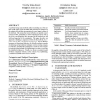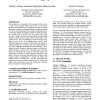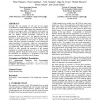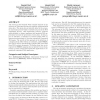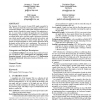WWW
2004
ACM
15 years 6 days ago
2004
ACM
The Semantic Web relies on the complex interaction of several technologies involving ontologies. Therefore, sophisticated Semantic Web applications typically comprise more than on...
WWW
2004
ACM
15 years 6 days ago
2004
ACM
A problem facing many textbook authors (including one of the authors of this paper) is the inevitable delay between new advances in the subject area and their incorporation in a n...
WWW
2004
ACM
15 years 6 days ago
2004
ACM
The success of the Semantic Web depends on the availability of ontologies as well as on the proliferation of web pages annotated with metadata conforming to these ontologies. Thus...
WWW
2005
ACM
15 years 6 days ago
2005
ACM
WWW
2005
ACM
15 years 6 days ago
2005
ACM
It has been a few years since the semantic Web was initiated by W3C, but its status has not been quantitatively measured. It is crucial to understand the status at this early stag...
WWW
2005
ACM
15 years 6 days ago
2005
ACM
The semantic web is expected to have an impact at least as big as that of the existing HTML based web, if not greater. However, the challenge lays in creating this semantic web an...
WWW
2005
ACM
15 years 6 days ago
2005
ACM
Currently, the vast majority of web sites do not support accessibility for visually impaired users. Usually, these users have to rely on screen readers: applications that sequenti...
WWW
2005
ACM
15 years 6 days ago
2005
ACM
The success of the Semantic Web crucially depends on the existence of Web pages that provide machine-understandable meta-data. This meta-data is typically added in the semantic an...
WWW
2005
ACM
15 years 6 days ago
2005
ACM
The Rich News system, that can automatically annotate radio and television news with the aid of resources retrieved from the World Wide Web, is described. Automatic speech recogni...
WWW
2005
ACM
15 years 6 days ago
2005
ACM
The Semantic Web consists of many RDF graphs nameable by URIs. This paper extends the syntax and semantics of RDF to cover such Named Graphs. This enables RDF statements that desc...

